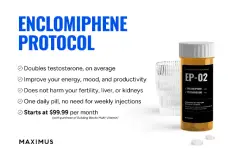What factors can falsely elevate your PSA level?
There are other factors that can affect the PSA level besides prostate cancer. The following conditions can lead to increased PSA levels:
This is the number one reason for PSA increases while on TRT.
Chronic Nonbacterial Prostatitis/Chronic Pelvic Pain Syndrome
It has been widely reported that more than 90 percent of men with prostatitis meet the criteria for chronic nonbacterial prostatitis/chronic pelvic pain syndrome (CNP/CPPS).
"Like many such poorly understood conditions, CNP/CPPS remains a challenging syndrome. Patients usually have symptoms consistent with prostatitis, such as painful ejaculation or pain in the penis, testicles or scrotum. They may complain of low back pain, rectal or perineal pain, or even pain along the inner aspects of the thighs. They often have irritative or obstructive urinary symptoms and decreased libido or impotence. As a rule, these patients do not have recurrent urinary tract infections. The physical examination is usually unremarkable, but patients may have a tender prostate."
Asymptomatic Prostatitis
Information presented at the NIH consensus conference added asymptomatic prostatitis as a new category, partly because of the widespread use of the prostate-specific antigen (PSA) test.
Clearly, symptomatic bacterial prostatitis can elevate the PSA test to abnormal levels. Asymptomatic prostatitis may also elevate the PSA level. In addition, patients who are being evaluated for other prostatic diseases may be found on biopsy to have prostatitis. There are no studies elucidating the natural history or appropriate therapy of this condition. It does appear that PSA levels return to normal four to six weeks after a 14-day course of antibiotics.23 Treatment is routinely recommended only in patients with chronic asymptomatic prostatitis known to elevate the PSA level. In these patients, it may be prudent to treat before drawing subsequent PSA samples.
Acute bacterial prostatitis requires prolonged antibiotic treatment to fully eradicate the infection and prevent it from evolving into a chronic prostatitis. Most guidelines and expert sources recommend therapy for multiple weeks rather than just a few daysmayoclinic.org. Below are the typical treatment duration ranges (in days) for common antibiotics, with notes on variations for severity and patient factors:
Trimethoprim-sulfamethoxazole (Bactrim, Septra)
Doxycycline (Vibramycin)
Ciprofloxacin (Cipro)
Norfloxacin (Noroxin)
Ofloxacin (Floxin)
Sources: Guidance on prostatitis treatment durations is drawn from clinical guidelines and expert resources, including UpToDate, the Infectious Diseases Society of America (IDSA) recommendations, and urology references. For acute bacterial prostatitis, these sources consistently advocate longer antibiotic courses (several weeks) rather than short courses mayoclinic.org. The exact duration can depend on the drug’s ability to penetrate prostatic tissue and the patient’s clinical response. In summary, a 2- to 4-week treatment period (often closer to 4 weeks) is typical for the antibiotics listed above in acute prostatitis (ncbi.nlm.nih.gov/aafp.org), with adjustments made for severe illness or specific pathogens as noted. Always ensure the full course is completed to maximize cure rates and reduce the risk of chronic infection mayoclinic.org.
Treatment of Prostatitis

From Medscape:
"Antibiotics that penetrate well into the acid milieu of the prostate are nonpolar and lipid-soluble and have a high measure of acid strength, a small molecular radius, and low serum protein binding. Drugs that best fit these criteria are the fluoroquinolones, doxycycline, minocycline (particularly effective against methicillin-resistant Staphylococcus aureus [MRSA]), trimethoprim (available in the United States only as trimethoprim-sulfamethoxazole [TMP-SMZ]), rifampin, and erythromycin. Of this group, the fluoroquinolones appear to achieve the best tissue levels."
There are other factors that can affect the PSA level besides prostate cancer. The following conditions can lead to increased PSA levels:
- Increasing age
- Benign prostate hyperplasia (BPH), a condition that commonly develops as those assigned male at birth age and causes the prostate to grow in size
- Inflammation or infection of the prostate, like prostatitis or a urinary tract infection
- Hormone medications, like testosterone
- Ejaculation, which can raise the PSA level for a short period of time (so it’s a good idea to avoid ejaculating for a few days before the test)
- Riding a bike, or anything that puts pressure on the area near the prostate (i.e., between the genitals and the anus)
This is the number one reason for PSA increases while on TRT.
Chronic Nonbacterial Prostatitis/Chronic Pelvic Pain Syndrome
It has been widely reported that more than 90 percent of men with prostatitis meet the criteria for chronic nonbacterial prostatitis/chronic pelvic pain syndrome (CNP/CPPS).
"Like many such poorly understood conditions, CNP/CPPS remains a challenging syndrome. Patients usually have symptoms consistent with prostatitis, such as painful ejaculation or pain in the penis, testicles or scrotum. They may complain of low back pain, rectal or perineal pain, or even pain along the inner aspects of the thighs. They often have irritative or obstructive urinary symptoms and decreased libido or impotence. As a rule, these patients do not have recurrent urinary tract infections. The physical examination is usually unremarkable, but patients may have a tender prostate."
Asymptomatic Prostatitis
Information presented at the NIH consensus conference added asymptomatic prostatitis as a new category, partly because of the widespread use of the prostate-specific antigen (PSA) test.
Clearly, symptomatic bacterial prostatitis can elevate the PSA test to abnormal levels. Asymptomatic prostatitis may also elevate the PSA level. In addition, patients who are being evaluated for other prostatic diseases may be found on biopsy to have prostatitis. There are no studies elucidating the natural history or appropriate therapy of this condition. It does appear that PSA levels return to normal four to six weeks after a 14-day course of antibiotics.23 Treatment is routinely recommended only in patients with chronic asymptomatic prostatitis known to elevate the PSA level. In these patients, it may be prudent to treat before drawing subsequent PSA samples.
Typical Antibiotic Therapy Durations for Acute Bacterial Prostatitis
Acute bacterial prostatitis requires prolonged antibiotic treatment to fully eradicate the infection and prevent it from evolving into a chronic prostatitis. Most guidelines and expert sources recommend therapy for multiple weeks rather than just a few daysmayoclinic.org. Below are the typical treatment duration ranges (in days) for common antibiotics, with notes on variations for severity and patient factors:
Trimethoprim-sulfamethoxazole (Bactrim, Septra)
- Typical Duration: Approximately 2–4 weeks (about 14–28 days) ncbi.nlm.nih.gov. Many experts favor a full 4-week course to ensure prostate infection is cleared and to prevent relapse aafp.org. For example, an older survey found most would treat around 3–4 weeks for prostatitis, even though some clinicians used shorter courses (aafp.org).
- Considerations: In mild cases that respond quickly, an initial 10–14 day course can be given, extending by another 2 weeks (to total ~4 weeks) if symptoms persist aafp.org. Severe cases (e.g. high fever or sepsis) often require hospital care with IV antibiotics initially, but the total antibiotic duration is still about 4 weeks (after improvement, patients transition to oral TMP-SMX to complete the 4-week regimen) aafp.org. This prolonged course helps reduce the risk of developing chronic infectionmayoclinic.org.
Doxycycline (Vibramycin)
- Typical Duration: Generally 2–4 weeks (14–28 days) when doxycycline is used for acute bacterial prostatitis aafp.org. While not a first-line choice for typical enteric bacteria, doxycycline may be used in certain scenarios (e.g. allergy to other drugs or targeting atypical organisms) and in those cases a multi-week course similar to other antibiotics is recommended.
- Considerations: Doxycycline is particularly considered if a sexually transmitted infection (STI) is suspected as the cause. In younger men at risk for Chlamydia or gonococcal prostatitis, guidelines recommend treating with an appropriate gonococcal agent plus doxycycline. For example, an STI-oriented regimen is a one-time ceftriaxone injection followed by about 14 days of oral doxycycline (100 mg twice daily) ncbi.nlm.nih.gov. This 2-week doxycycline course targets Chlamydia trachomatis, which is a common coinfection in STI-related prostatitis. Outside of STI cases, doxycycline is less commonly used for acute prostatitis caused by gram-negative rods, but if used, the duration is typically still on the order of several weeks (often 2–4 weeks) similar to other agents ncbi.nlm.nih.gov.
Ciprofloxacin (Cipro)
- Typical Duration: Approximately 2–4 weeks (about 14–28 days) ncbi.nlm.nih.gov. Fluoroquinolones like ciprofloxacin penetrate prostatic tissue well, and a four-week course (28 days) is commonly recommended in practice to achieve a cure aafp.org. Many clinical sources consider 4 weeks the standard for acute prostatitis therapy with ciprofloxacin, though some mild cases may be treated for a minimum of 2 weeks if there is rapid improvement aafp.org.
- Considerations: For severe acute prostatitis (e.g. the patient is bacteremic or very ill), initial therapy may be IV broad-spectrum antibiotics (often a fluoroquinolone or beta-lactam plus aminoglycoside). Once the patient stabilizes and becomes afebrile, they are switched to oral ciprofloxacin to complete about 2–4 weeks total of therapy aafp.org. Even in outpatient cases, if symptoms have not completely resolved by 14 days, treatment is typically extended to 4 weeks total aafp.org. This approach – treating for roughly a month – is supported by urologic and infectious disease guidelines to ensure the infection is fully eradicated and to reduce the chance of chronic prostatitis developing mayoclinic.org.
Norfloxacin (Noroxin)
- Typical Duration: Typically, norfloxacin therapy for acute prostatitis lasts about 4 weeks (28 days). As a fluoroquinolone, norfloxacin would be given for a similar duration as ciprofloxacin or other fluoroquinolones. Clinical studies have employed a 28-day course of norfloxacin in prostatitis, and this has been associated with successful cure rates aafp.org.
- Considerations: Norfloxacin is less commonly prescribed today (ciprofloxacin or levofloxacin are more frequently used), but it has documented efficacy in prostate infections. For instance, one case series in prostatitis patients who had failed other antibiotics showed that norfloxacin 400 mg twice daily for 28 days achieved cure in a majority of cases aafp.org. Thus, when norfloxacin is used, a month-long course is generally indicated. As with other agents, therapy should be guided by culture results and patient response; if the infection is severe, initial IV treatment would be followed by oral norfloxacin to complete roughly 4 weeks total treatment.
Ofloxacin (Floxin)
- Typical Duration: 2–4 weeks of therapy is the usual range, with around 4 weeks often recommended for ofloxacin as well (aafp.org). Ofloxacin, another fluoroquinolone, achieves good penetration into the prostate, and a prolonged course (on the order of a month) is typically used to treat acute infections.
- Considerations: Clinical experience suggests that an extended course (4+ weeks) of ofloxacin yields high cure rates in prostatitis. For example, in comparative trials for prostatitis (acute and chronic), ofloxacin given for about 5 weeks showed better cure rates than some older antibiotics (aafp.org). Therefore, standard practice is to treat with ofloxacin for at least a couple of weeks, and more often a full 4-week course, to ensure symptom resolution. As with other fluoroquinolones and TMP-SMX, treatment may be lengthened up to 6 weeks in refractory cases, and a follow-up urine culture is often obtained after completing therapy to confirm clearance of infection (aafp.org).
Sources: Guidance on prostatitis treatment durations is drawn from clinical guidelines and expert resources, including UpToDate, the Infectious Diseases Society of America (IDSA) recommendations, and urology references. For acute bacterial prostatitis, these sources consistently advocate longer antibiotic courses (several weeks) rather than short courses mayoclinic.org. The exact duration can depend on the drug’s ability to penetrate prostatic tissue and the patient’s clinical response. In summary, a 2- to 4-week treatment period (often closer to 4 weeks) is typical for the antibiotics listed above in acute prostatitis (ncbi.nlm.nih.gov/aafp.org), with adjustments made for severe illness or specific pathogens as noted. Always ensure the full course is completed to maximize cure rates and reduce the risk of chronic infection mayoclinic.org.
Treatment of Prostatitis
From Medscape:
"Antibiotics that penetrate well into the acid milieu of the prostate are nonpolar and lipid-soluble and have a high measure of acid strength, a small molecular radius, and low serum protein binding. Drugs that best fit these criteria are the fluoroquinolones, doxycycline, minocycline (particularly effective against methicillin-resistant Staphylococcus aureus [MRSA]), trimethoprim (available in the United States only as trimethoprim-sulfamethoxazole [TMP-SMZ]), rifampin, and erythromycin. Of this group, the fluoroquinolones appear to achieve the best tissue levels."
Last edited:















